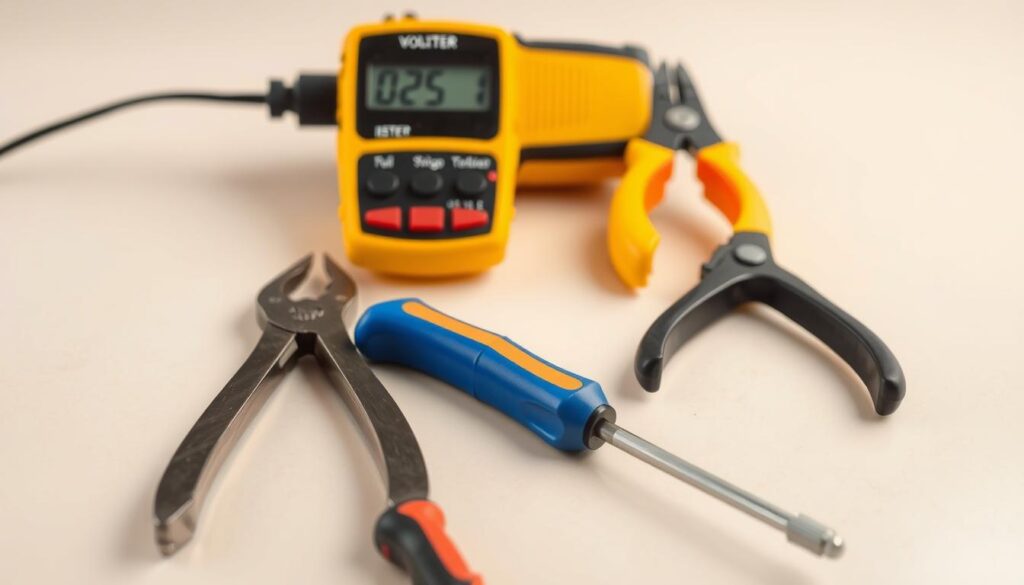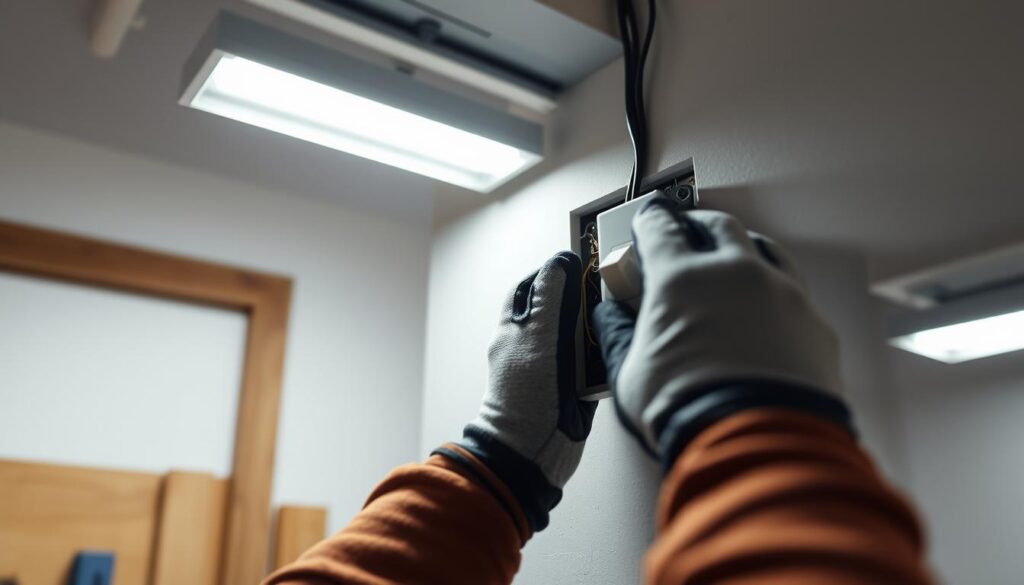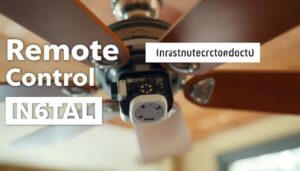Are flickering lights driving you mad? You’re not alone. Many homeowners find themselves puzzled and concerned by this common issue.
Flickering lights are not just annoying; they can also be a sign of an underlying problem that needs attention. According to certified master electrician Kyle Krueger, there could be various reasons behind this issue, ranging from minor to major electrical issues.
This comprehensive guide will walk you through identifying the cause of the flickering and provide step-by-step solutions. Whether it’s a simple light fixture issue or a more serious wiring problem, we’ll help you determine the best course of action.
Key Takeaways
- Understand the common causes of flickering lights
- Learn how to identify the source of the problem
- Discover step-by-step solutions to fix the issue
- Know when to call a professional electrician
- Ensure your lighting is safe and functional
Understanding Why Light Fixtures Flicker
The annoying flicker of your light fixtures can be more than just a minor irritation; it often signals an underlying issue. Flickering lights can be caused by various factors, ranging from simple problems like loose bulbs to more complex electrical issues.
Common Causes of Flickering Lights
Flickering lights are often the result of loose or poor electrical connections, or faulty wiring. According to Krueger, “loose electrical connections, poor connections, or faulty wiring” are the most dangerous situations that could cause lights to flicker. This problem is more common in older homes, where the electrical system may be outdated.
Some common warning signs that indicate flickering lights are symptoms of serious electrical problems include:
- Loose connections causing arcing—a type of electrical discharge—in the junction box, which can lead to electrical fires.
- Continual arcing creating high temperatures in junction boxes that can ignite surrounding materials.
- Flickering accompanied by buzzing or popping sounds, which requires immediate professional attention.
When Flickering Lights Indicate Serious Problems
Certain patterns of flickering across multiple fixtures may indicate problems with the main electrical supply. For instance, if you notice that multiple lights are flickering in sync, it could be a sign of a more significant issue with your electrical system. Statistics show that electrical distribution or lighting equipment is a common cause of home fires, emphasizing the need to address flickering lights promptly.
| Causes of Flickering Lights | Potential Risks |
|---|---|
| Loose or Poor Electrical Connections | Arcing, Electrical Fires |
| Faulty Wiring | Electrical Discharge, Fire Hazards |
| Outdated Electrical Systems | Increased Risk of Electrical Issues |
It’s crucial to identify the cause of flickering lights to prevent potential electrical hazards. If you’re unsure about the cause or if the issue persists after checking the obvious causes, it’s recommended to consult a professional electrician.
Safety First: Before You Begin
Ensuring your safety is paramount when dealing with electrical issues like flickering lights. Electrical work can be hazardous if not done properly.
Essential Safety Precautions
Before starting, turn off the power to the light fixture at your circuit breaker or fuse box. Verify that the fixture is completely dark before beginning work. Use a non-contact voltage tester to ensure there is no electricity flowing to the fixture.
Tools You’ll Need
To diagnose and fix flickering light fixtures, you’ll need a variety of tools. These include:
- Screwdrivers (flathead and Phillips)
- Voltage tester
- Wire strippers
- Pliers (needle-nose and slip-joint)
- Replacement parts (wire nuts, electrical tape, spare bulbs)
| Tool | Purpose |
|---|---|
| Screwdrivers | Removing fixture covers and switch plates |
| Voltage Tester | Checking for live wires |
| Wire Strippers | Stripping insulation from wires |

Diagnosing the Source of Flickering
Diagnosing the source of flickering lights is crucial to applying the correct fix. To start, you need to observe the flickering pattern and identify any accompanying symptoms that could indicate the underlying cause.
Is It One Light or Multiple Lights?
First, determine if the flickering is isolated to one light or if it’s affecting multiple lights. If it’s just one light, the issue might be with the bulb or the fixture itself. However, if multiple lights are flickering, it could indicate a more widespread problem with your electrical system, such as a wiring issue or an overloaded circuit.
Timing Patterns of Flickering
Next, observe the timing pattern of the flickering. Is it constant or intermittent? Does it flicker at specific times of the day? Flickering that occurs at the same time every day might be related to the usage patterns of other electrical appliances in your home. For instance, if your lights flicker every time you turn on your air conditioner, it could indicate that your electrical circuit is overloaded.
Accompanying Symptoms
Pay attention to any accompanying symptoms such as buzzing, popping, or humming sounds. These sounds can be indicative of specific issues. For example, buzzing sounds might suggest a problem with dimmer switches or incompatible bulbs. “It monitors the various circuit wiring for arcing,” says Krueger, highlighting the importance of identifying such symptoms. Popping or crackling sounds, on the other hand, can signal dangerous arcing that requires immediate attention from an electrician.
Furthermore, certain smells like burning or ozone accompanying flickering lights can indicate serious electrical problems. Similarly, if you notice vibrations or physical movement of fixtures during flickering, it could point to loose connections or other specific issues that need to be addressed.
If the random flickering continues for no other known cause, and especially if you hear popping sounds, it’s advisable to contact an electrician right away. Meanwhile, you can cut off power to the potentially damaged wire by shutting off the corresponding circuit breaker in your breaker box.
Quick Fixes for Flickering Light Fixtures
Before seeking professional help for flickering lights, consider these simple and effective solutions. Flickering light fixtures can be a nuisance, but often, the issue can be resolved with some basic troubleshooting.
Tightening Loose Bulbs
One of the simplest fixes is to ensure that the bulb is screwed in tightly. A loose bulb can cause flickering, so checking and tightening it can often resolve the issue. Make sure to turn off the power to the fixture before attempting to tighten the bulb.
Checking Fixture Connections
If tightening the bulb doesn’t work, the next step is to check the connections within the fixture. Loose or corroded connections can cause flickering. Turn off the power from the circuit breaker and inspect the wiring and connections. If you’re not comfortable with this, it may be best to consult a professional.
Replacing Faulty Light Switches
If the issue isn’t with the bulb or fixture, the problem might lie with the light switch. An old dimmer switch, especially one designed for incandescent bulbs, may not work well with LEDs, leading to flickering. Check if your dimmer switch is compatible with your bulbs. If not, consider replacing it with a compatible dimmer, such as the Lutron Caseta. Before starting, ensure the power is turned off from the circuit breaker.
To replace a faulty light switch, follow these steps:
- Turn off the power to the switch from the circuit breaker.
- Remove the faceplate and switch.
- Check the wiring connections and take note of how they are connected.
- Install the new switch, ensuring the wiring connections are secure and correct.
- Replace the faceplate and turn the power back on.
It’s crucial to select the right replacement switch for your fixture type. For standard switches, the wiring is typically straightforward. However, dimmer switches may require more attention to ensure compatibility with your lighting setup.
| Switch Type | Wiring Requirements | Compatibility Considerations |
|---|---|---|
| Standard Switch | Simple wiring, typically just live and neutral connections. | Generally compatible with most light fixtures. |
| Dimmer Switch | More complex wiring, may require additional connections for dimming functionality. | Must be compatible with the type of bulbs used (e.g., LED, incandescent). |

After replacing the switch, test it to ensure the flickering issue is resolved. If the problem persists, it may be necessary to investigate further or consult a professional electrician.
Solving Bulb and Fixture Compatibility Issues
One common cause of flickering lights is the incompatibility between bulbs and lighting fixtures in your home. Ensuring that your bulbs and fixtures are compatible is crucial for maintaining a stable and flicker-free lighting system.
LED Bulbs and Dimmer Switch Problems
LED bulbs can sometimes be incompatible with dimmer switches, leading to flickering. This is because LED bulbs require specific dimming technology to function correctly with dimmer switches. If you’re experiencing flickering with LED bulbs on a dimmer switch, try replacing the bulbs with ones that are specifically designed to be dimmable and compatible with your dimmer switch.
Choosing the Right Bulb for Your Fixture
Selecting the right bulb for your fixture is essential. Check the fixture’s specifications to ensure the bulb you choose matches its requirements. For instance, if your fixture is rated for a certain wattage, using a bulb with a higher wattage can cause flickering or other issues.
Smart Light Troubleshooting
Smart lights can flicker due to Wi-Fi connectivity issues or software problems. To troubleshoot, first ensure your smart lights are within a strong Wi-Fi signal range. You can also try restarting your router or updating the firmware of your smart lights and their controlling app. If issues persist, resetting your smart bulbs and reconfiguring them may resolve the problem.
To summarise, some key steps to resolve flickering issues include:
- Checking the compatibility between bulbs and fixtures
- Ensuring dimmer switches are compatible with LED bulbs
- Troubleshooting Wi-Fi connectivity for smart lights
- Updating firmware and software for smart lighting systems
Fixing a Flickering Light Fixture: Advanced Solutions
When basic fixes don’t resolve the flickering issue, it’s time to explore advanced solutions. Flickering lights can be a symptom of more complex electrical problems, requiring a deeper investigation.
Addressing Circuit Overload Issues
Circuit overload occurs when too many devices are connected to a single circuit, causing the lights to flicker. To address this, you should identify the overloaded circuit and redistribute some of the devices to other circuits. You can also consider upgrading your electrical panel to increase the overall capacity.
Dealing with Voltage Fluctuations
Voltage fluctuations can cause lights to flicker. This issue often requires professional diagnosis. An electrician can assess your home’s wiring and electrical system to determine the cause of the voltage fluctuations and recommend the necessary repairs or upgrades.
Upgrading Outdated Wiring and Fixtures
Outdated wiring, such as knob and tube or aluminium wiring, can lead to flickering lights and safety hazards. Upgrading to modern wiring and fixtures can resolve these issues. Consider hiring a professional to assess and upgrade your home’s electrical system.
| Type of Wiring | Risks | Upgrade Solution |
|---|---|---|
| Knob and Tube Wiring | Fire hazard, outdated | Replace with modern copper wiring |
| Aluminium Wiring | Oxidation risk, fire hazard | Replace with copper wiring or use COPALUM connectors |
Upgrading your electrical system not only fixes flickering lights but also enhances your home’s safety and efficiency. Consider consulting an electrician to plan and execute the upgrades.
When to Call a Professional Electrician
Knowing when to call an electrician can save you from potential electrical hazards. If you notice repeated tripping of arc fault circuit interrupters or flickering lights with no known cause, it’s time to seek help. Flickering accompanied by popping or crackling sounds is another serious indicator. In older homes, unresolved light flickering can signal outdated wiring. Consult a licensed electrician to address these issues. They can diagnose the problem in your home or room and provide a solution, ensuring your safety and compliance with local regulations regarding electrical repairs.



